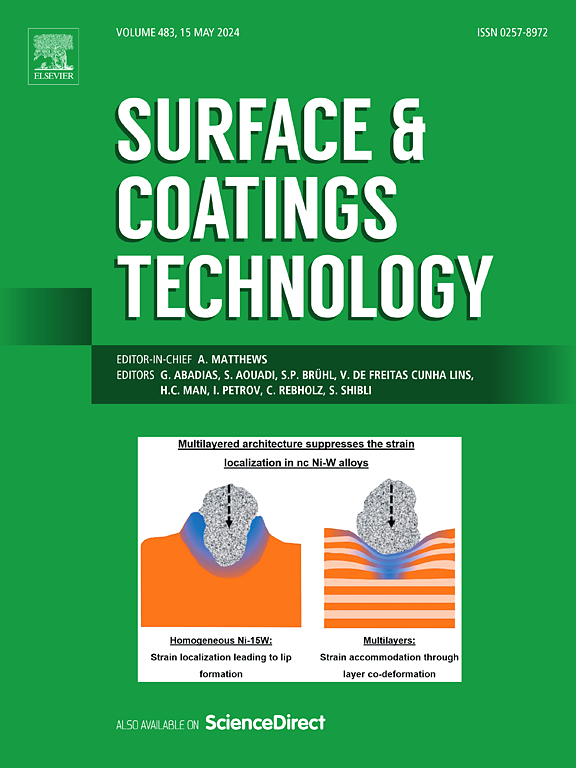超声等离子喷涂Al2O3/PF复合涂层烧蚀损伤演化研究
IF 5.3
2区 材料科学
Q1 MATERIALS SCIENCE, COATINGS & FILMS
引用次数: 0
摘要
树脂基绝缘支架作为现代国防武器系统的关键部件,是电磁轨道发射器不可或缺的重要组成部分。尽管它们具有优异的机械性能和电绝缘性,但它们较差的抗烧蚀和抗侵蚀性限制了它们在恶劣服务环境中的应用。在本研究中,利用超音速等离子喷涂系统将Al2O3和Al2O3/PF粉末交替喷涂到玻璃纤维增强环氧树脂基板上,成功制备了Al2O3/PF复合涂层。研究了不同烧蚀距离和烧蚀时间下的烧蚀行为和烧蚀性能。建立响应面模型,将烧蚀距离、循环次数与涂层弹性模量、硬度、表面形貌等性能联系起来,探讨烧蚀过程中涂层降解的时空演变及其潜在机制。结果表明,在110 mm处烧蚀的涂层性能优于在90 mm和100 mm处烧蚀的涂层。在90 mm和100 mm的距离上,经过100次和150次烧蚀后,表面完全碳化。而在110 mm处,随着烧蚀次数的增加,碳化程度逐渐增加。构建的响应面揭示了烧蚀损伤的时空特征。这些发现为研究复合涂层的损伤演化机制提供了重要的理论见解,并为评估树脂基绝缘支架在极端环境下的性能和破坏行为提供了依据。本文章由计算机程序翻译,如有差异,请以英文原文为准。
Research on the ablation damage evolution of Al2O3/PF composite coatings deposited by supersonic plasma spraying on resin matrix surfaces
As a key component in modern defense weapon systems, resin-based insulating supports are indispensable in electromagnetic rail launchers. Although they exhibit excellent mechanical properties and electrical insulation, their poor ablation and erosion resistance limits their application in harsh service environments. In this study, Al2O3/PF composite coatings were successfully fabricated by alternately spraying Al2O3 and Al2O3/PF powders onto glass fiber-reinforced epoxy resin substrates using a supersonic plasma spraying system. Ablation behavior and degradation were investigated under varying ablation distances and ablation times. Response surface models were established to correlate ablation distance and cycle number with coating performance, including elastic modulus, hardness, and surface morphology, and to explore the spatiotemporal evolution and underlying mechanisms of coating degradation during ablation. The results indicate that coatings ablated at a distance of 110 mm exhibited superior performance compared to those at 90 mm and 100 mm. At distances of 90 mm and 100 mm, complete surface carbonization occurred after 100 and 150 ablation times. In contrast, at 110 mm, the degree of carbonization gradually increased with the number of ablation times. The constructed response surfaces revealed the spatiotemporal characteristics of the ablation-induced damage. These findings provide important theoretical insights into the damage evolution mechanisms of composite coatings and offer a basis for evaluating the performance and failure behavior of resin-based insulating supports in extreme environments.
求助全文
通过发布文献求助,成功后即可免费获取论文全文。
去求助
来源期刊

Surface & Coatings Technology
工程技术-材料科学:膜
CiteScore
10.00
自引率
11.10%
发文量
921
审稿时长
19 days
期刊介绍:
Surface and Coatings Technology is an international archival journal publishing scientific papers on significant developments in surface and interface engineering to modify and improve the surface properties of materials for protection in demanding contact conditions or aggressive environments, or for enhanced functional performance. Contributions range from original scientific articles concerned with fundamental and applied aspects of research or direct applications of metallic, inorganic, organic and composite coatings, to invited reviews of current technology in specific areas. Papers submitted to this journal are expected to be in line with the following aspects in processes, and properties/performance:
A. Processes: Physical and chemical vapour deposition techniques, thermal and plasma spraying, surface modification by directed energy techniques such as ion, electron and laser beams, thermo-chemical treatment, wet chemical and electrochemical processes such as plating, sol-gel coating, anodization, plasma electrolytic oxidation, etc., but excluding painting.
B. Properties/performance: friction performance, wear resistance (e.g., abrasion, erosion, fretting, etc), corrosion and oxidation resistance, thermal protection, diffusion resistance, hydrophilicity/hydrophobicity, and properties relevant to smart materials behaviour and enhanced multifunctional performance for environmental, energy and medical applications, but excluding device aspects.
 求助内容:
求助内容: 应助结果提醒方式:
应助结果提醒方式:


